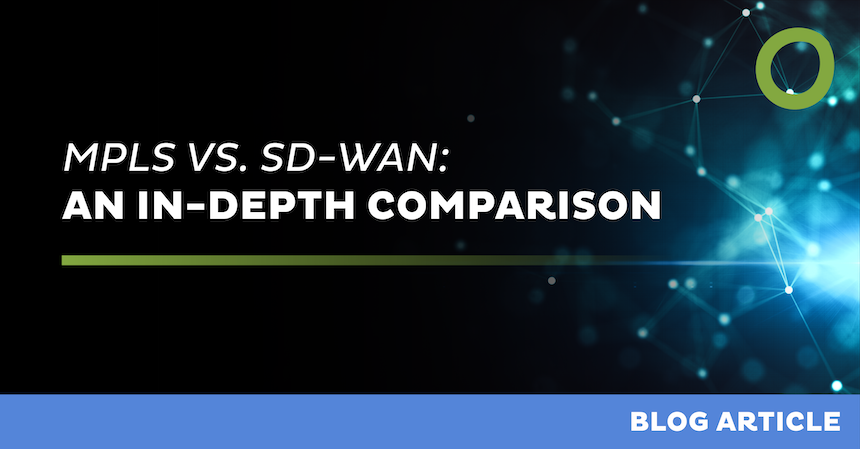
MPLS vs. SD-WAN: An In-Depth Comparison


Why Network Technology Matters for Modern Enterprises
Modern enterprises need robust and efficient network technology, which leaves many IT leaders debating the MPLS vs. SD-WAN network solution. The right connectivity type ensures seamless communication, supports critical cloud services like data storage and SaaS applications, and enhances overall productivity.
As businesses increasingly rely on data and connectivity to power new initiatives, choosing the right WAN network services can become a make-or-break operational decision.
Read on for a comprehensive look at MPLS and SD-WAN uses and their distinct benefits.
And check out how Open Systems supports seamless migrations from MPLS to SD-WAN.
Understanding MPLS
What is MPLS (Multiprotocol Label Switching)?
MPLS is a technique used in high-performance telecommunications networks. It directs data from one node to the next based on short path labels rather than long network addresses. This reduces the complexity of lookups in routing tables and speeds up traffic flow.
How does MPLS Work?
Label Switching Mechanism
MPLS assigns labels to packets, which routers use to make data-forwarding decisions. This process bypasses traditional IP routing tables, leading to faster data transmission.
It can be likened to a fast-pass system at an amusement park. Instead of standing in line and having each ticket checked at every ride (like traditional IP routing), visitors get a “fast pass” (a label) that directs them quickly through special lanes, allowing them to reach their destinations more efficiently.
In other words, a label edge router (LER) assigns packets a label. As packets move through the network, label switching routers (LSRs) read and swap the labels until they reach their destination.
Data Forwarding Process
This is like a relay race. Each runner (router) in the race receives a baton (data packet with a label) and knows exactly who to pass it to next without stopping to check a map.
Making the jump from MPLS? Open Systems is a SASE transformation expert.
Understanding SD-WAN
What is SD-WAN (Software-Defined Wide Area Network)?
SD-WAN is a virtual WAN architecture that allows enterprises to leverage any combination of transport services — including MPLS, LTE, and broadband internet services to securely connect users to applications.
How does SD-WAN Work?
Overlay Network Concept
SD-WAN creates an overlay virtual private network (VPN), which abstracts the underlying physical connections. This provides centralized management, simplified deployment of network services, and secure connections through encryption.
Imagine it like a virtual highway system built over existing roads. It reroutes traffic efficiently without altering the underlying roads.
Simply put, business-critical application traffic can be routed via the fastest and highest quality underlay while non-essential traffic is deprioritized. In this way, SD-WAN creates a flexible, performant, and encrypted network layer over existing internet connections.
Centralized Management
With SD-WAN, network traffic is managed through a centralized control function, enabling more efficient and flexible routing based on application requirements and real-time network conditions.
Consider this the traffic control center that monitors and directs traffic flow across the entire city. This center can automate traffic failovers, quickly adjust routes, and manage traffic signals to ensure smooth and efficient travel.
Want a deeper dive? Visit our page on understanding SD-WAN.
Key Differences Between MPLS vs. SD-WAN
The main difference between MPLS and SD-WAN is that MPLS belongs to the underlay — similar to a physical connectivity circuit with guaranteed performance and reliability in specific point-to-point service level agreements (SLAs).
SD-WAN forms the overlay — a virtual network built on top of physical connectivity including internet or MPLS lines. This means there is less of an "either-or" when it comes to MPLS and SD-WAN; it’s more use-case-dependent, where a complementary approach is possible.
Cost Comparison
For IT leaders, total cost of ownership (TCO) is crucial. MPLS typically has higher setup and operational costs because it requires dedicated circuits and specialized equipment. SD-WAN, on the other hand, leverages existing and more cost-efficient internet connections, reducing expenses.
When conducting a TCO analysis, it’s important to consider hardware, software, maintenance, and potential downtime costs between MPLS vs. SD-WAN.
Performance and Reliability
MPLS is known for consistent performance, making it suitable for critical applications. For IT leaders, this equals predictable performance, high availability, and dedicated circuits.
SD-WAN also offers strong performance, with the benefits of dynamic path selection, application-aware routing, and multiple connections to provide failover options for strong network resilience.
Performance testing is a good option for determining the real-world performance of MPLS vs. SD-WAN solutions for your most mission-critical applications.
Scalability and Flexibility
Organizations in growth mode need networking solutions that can grow with them. SD-WAN offers significant advantages in scalability and flexibility, allowing businesses to easily add new locations or support remote workforces without major infrastructure changes.
It’s best to plan for future growth, considering how cost-effectively your network can scale with wide area networks rather than MPLS.
Security Features
For industries with stringent regulatory requirements, such as finance and healthcare, it’s key to understand how each technology can support compliance. SD-WAN networks provide inherent security through encrypted VPN connections that can simplify compliance with regulations like HIPAA.
MPLS can be considered private in the sense that only one organization uses specific MPLS paths. However, MPLS does not encrypt traffic and hence, packets can be read if they are intercepted along the path.
For this reason, MPLS requires additional security features to ensure data protection across private circuits. Additional firewalls are usually needed to protect the local area network (LAN) and wide area network (WAN) from internet threats, while many SD-WAN solutions come with a built-in firewall.
Management and Monitoring
SD-WAN offers centralized management and easier monitoring, providing IT teams with greater control and visibility over the network compared to MPLS. A single pane of glass manages the entire network, simplifying operations and reducing administrative overhead.
While MPLS networks can be resource-intensive, they usually offer robust tools for monitoring network performance and managing traffic flows, ensuring high levels of control and visibility for IT teams.
SD-WAN and MPLS Use Cases and Best Practices
When to Use MPLS?
MPLS is ideal for industries requiring guaranteed performance and reliability for specific point-to-point connections — such as finance, healthcare, and manufacturing, where critical applications and data integrity are paramount.
When to Use SD-WAN?
SD-WAN solutions suit businesses seeking cost-effective, flexible, and scalable networking solutions. It is particularly beneficial for companies with multiple branches or remote locations.
Hybrid Approaches?
A hybrid approach leverages the strengths of both MPLS and SD-WAN, providing a balance of performance, reliability, and cost-efficiency. This can be useful for:
- global manufacturing enterprises: employing MPLS for critical applications that require high performance between two locations — such as real-time high-resolution video calls between two offices or design file transfers between the design office and a machine — while using SD-WAN for cloud-based applications
- financial institutions: maintaining encrypted VPN tunnels over reliable MPLS connections for sensitive transactions and big data transfers, while implementing SD-WAN over the internet to support branch offices and remote workers
- healthcare providers: using MPLS for medical applications that require low latency, while SD-WAN provides scalable and cost-effective connectivity for administrative functions
Still curious? Learn more about Hybrid-WAN’s applications here.
Evolution of Networking Technologies
Innovations in MPLS
- Segment Routing MPLS (SR-MPLS): segment routing is a significant advancement that simplifies the MPLS architecture. It allows packets to carry a list of segments, representing the path through the network, which enhances scalability and reduces the state information that routers need to maintain; this routing technique also applies to IPv6
Advances in SD-WAN
- Performance SLAs for SD-WAN: Various SD-WAN solution providers now offer service level agreements (SLAs) on the network or application level; previously, the guaranteed connectivity performance with MPLS was a key benefit for companies and a reason to delay moving to SD-WAN. But by leveraging several WAN transport services — including MPLS as an underlay for a high-performance SD-WAN overlay — it’s possible to offer even better SLAs. In addition, performance will soon be measured and optimized for individual user groups — user-based application experience SLAs.
- A secure access service edge (SASE) architecture: With the network transformation to an SD-WAN, a castle-and-moat security architecture (in which the internal network is protected from the external internet) no longer holds true. Instead, zero-trust strategies need to be implemented where users, data, and applications are protected from all threats: on-premises and in the internal network, remotely on the internet, or in the cloud.
- Integration with AI and Machine Learning: AI is transforming SD-WAN solutions by making networks smarter and more efficient. AI can enhance user and app experience by automating traffic optimization, increase network performance with predictive maintenance, and improve security with holistic monitoring, alerts, and defense of individual threat landscapes.
- SD-WAN Exchange: This innovation is revolutionizing how enterprises connect different SD-WAN technologies, including IoT environments and integration with multi-cloud environments; it optimizes data pathways and provides enhanced connectivity for cloud-based services.
Open Systems’ Industry-Leading SD-WAN Services
Open Systems designs cutting-edge SD-WAN solutions to meet the diverse needs of modern businesses. With a focus on security, performance, and flexibility, Open Systems ensures seamless connectivity and optimized network management, helping organizations stay competitive.
Questions about MPLS or SD-WAN uses? Want to chat migration to SD-WAN? We’d love to hear from you.
Leave Complexity
Behind
To learn how Open Systems SASE Experience can benefit your organization, talk to a specialist today.
Contact Us



